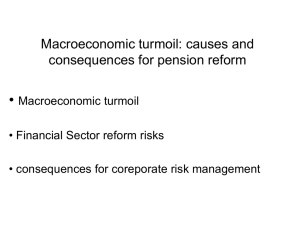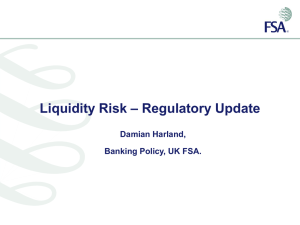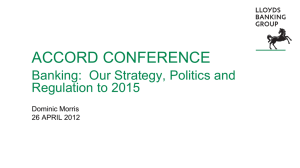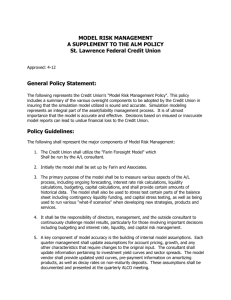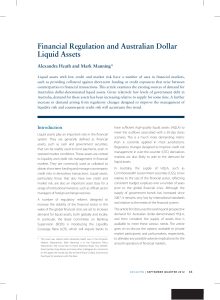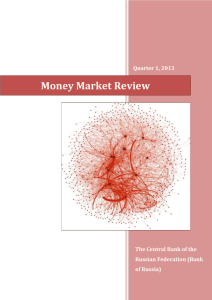Recent Financial market developments
advertisement
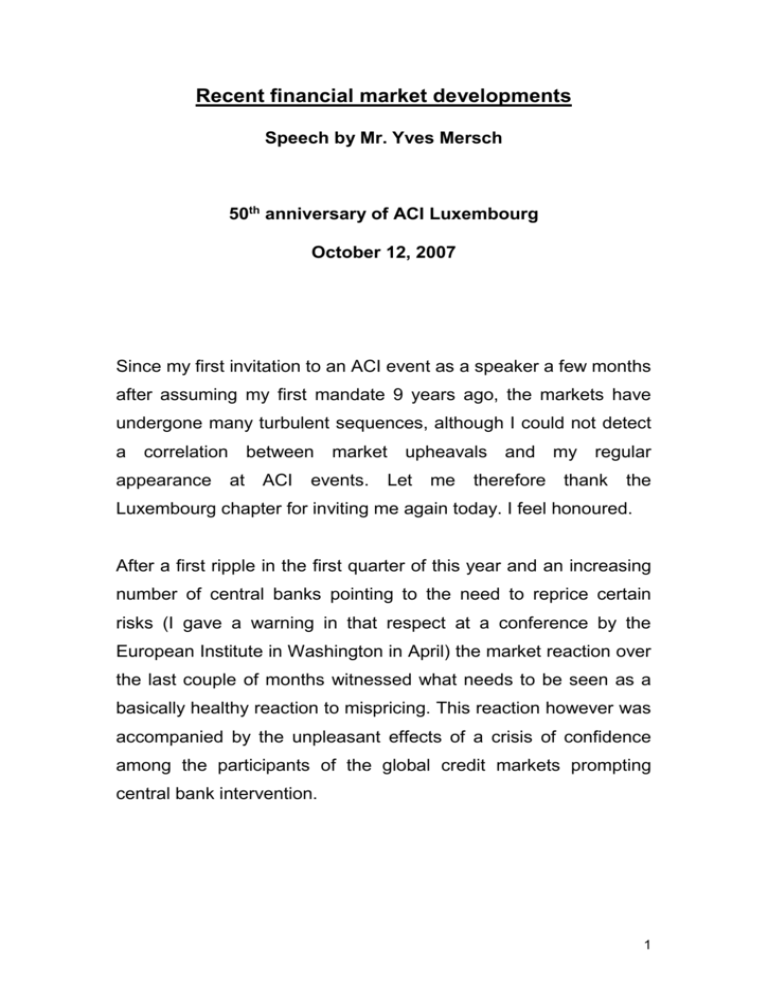
Recent financial market developments Speech by Mr. Yves Mersch 50th anniversary of ACI Luxembourg October 12, 2007 Since my first invitation to an ACI event as a speaker a few months after assuming my first mandate 9 years ago, the markets have undergone many turbulent sequences, although I could not detect a correlation between market upheavals and my regular appearance at ACI events. Let me therefore thank the Luxembourg chapter for inviting me again today. I feel honoured. After a first ripple in the first quarter of this year and an increasing number of central banks pointing to the need to reprice certain risks (I gave a warning in that respect at a conference by the European Institute in Washington in April) the market reaction over the last couple of months witnessed what needs to be seen as a basically healthy reaction to mispricing. This reaction however was accompanied by the unpleasant effects of a crisis of confidence among the participants of the global credit markets prompting central bank intervention. 1 Since I agreed to speak about the turbulence in financial markets, many actions have been taken and a policy agenda for drawing the lessons is emerging. Allow me therefore briefly to highlight the main events, before commenting on the experience we acquired inside the Eurosystem during these weeks and months with our elaborate toolbox of instruments and operations. I will conclude with some tentative lessons to be drawn in terms of transparency, valuation, market functioning and supervisory framework adjustment. At this stage of collecting evidence, I will not dwell on the macroeconomic consequences of this turbulence which took place against the background of a strong performance of the global economy. The momentum of past dynamics still outweighs potential downward risks to the baseline scenario. I. What happened in the markets If many expected turbulence, the specific features and the transmission mechanisms were less clearly anticipated. Many were barking up the wrong tree: Hedge funds and private equity were not the main culprits but suffered. 2 Let me sum up the unfolding of events in 6 points: 1. Credit spreads reach record lows in the first half of 2007 The combination of relatively low interest rates for a long period of time, the trend to lay off credit risk out of balance sheets and to securitize and an increasing focus on short-term returns have led to a strong demand for credit risk, especially from non-bank investors. As a result credit spreads fell to all-time lows, leading to a mispricing of credit risks. Additionally, many investors relied greatly on credit rating agencies for the valuation of complex financial instruments and their use as collateral. 2. Strong economies and higher commodity prices were fuelling expectations of tighter monetary policy before the crisis started. In the first half of the year the economic situation proved to be very robust. Most major central banks were normalising interest rates. Strong demand for commodities put upward pressure on prices so that interest rates were rising in the first half of the year. 3. Mortgage rate re-settings at higher interest rate levels caused delinquency rates to rise, most pronounced in the sub-prime mortgage market. 3 This led to losses in the hedge fund sector and increasing difficulties in finding a fair value price for structured deals. Moreover, investment funds experienced difficulties in NAV pricing, resulting in the temporary closures of some funds. Asset-backed securities with high credit ratings have proved not to be as sound, nor as liquid as they appeared. Some of those structured investment vehicles or conduits were extensively leveraged and strongly dependent on short-term funding. In the absence of liquidity, sponsoring banks had to fund off-balance-sheet vehicles from their own balance sheet. This led to deleveraging and forced asset sales. 4. Higher default rates caused the first bankruptcies in the US and credit spreads started to rise. Risk aversion spread to all asset classes. Forced sales to cover margin requirements saw volatility rise sharply (VIX doubled from 15 to 30 %). The unwinding of riskier positions caused stock markets to fall (Stoxx50 -11 %) and carry trades were liquidated (EURJPY fell from 169 to 152, a 10 % appreciation). As markets fell, margin requirements rose further. The uncertainty about the pricing of some instruments added additional pressure. 5. As the credit crisis spread further short-term liquidity evaporated. Short-term funding in the interbank market became unavailable, causing casualties amongst banks and 4 funds. In Europe, IKB and Landesbank Sachsen were rescued from insolvency. Northern Rock followed later. Funding in the primary market was impossible for banks. Trading in the secondary market stopped, with the exception of government issues. 6. The effective shut-down of the refinancing pipeline left banks to rely on short-term funding from central banks. Neither primary issues nor short-term papers, such as ABS or ABCP, could be placed in the market. Banks hoarded liquidity in order to be safe from unexpected outflows or the unknown extent of write-downs. Because the usual market refinancing possibilities were blocked banks relied on highly rated collateral for their funding and the liquidity provided by the central bank. The spread between EONIA and three-month Euribor rose to the highest level ever at 70 bps and has remained high. Unsecured trading in the money market beyond one week effectively ceased to exist. II. Central bank reaction function As liquidity retracted first from the credit markets, then money markets, intermediation vanishing, central banks had to move in: to restore orderly market conditions; ensure the integrity of 5 monetary transmission channels, and to ensure financial stability or prevent a systemic crisis. In view of the confidence crisis among market participants, due to uncertainty about financial individual exposures, the issues at stake were: 1) to have money market rates evolve close to the policy rates; 2) to address the term structure problem to the extent that it was threatening the first issue; 3) and thirdly to address the distributional problem of liquidity among market participants for reasons of financial stability. The somewhat more complex and elaborate toolbox of the Eurosystem proved very valuable in this respect. - this applies to the instruments used to provide liquidity: the MRO and LTRO - this applies to minimum reserve features - this applies to the number of counterparties with direct access to central bank money - this applies finally to the range of eligible collateral Let me say a word about each of these features of the Eurosystem operational framework: 1. At moments of term structure difficulties and shortening of the liquidity constraints, it is of advantage to have both: oneweek and three-month liquidity providing tenders conducted weekly and monthly. Fine tuning operations and 6 extraordinary additional tenders, according to standard procedures, allowed a commensurate response within a familiar context, rather than adding to prevailing uncertainty by introducing, in an emergency context, untested new facilities, instruments or procedures. 2. In monetary policy operations, the Eurosystem grants direct access to liquidity to a large number of credit institutions. All euro-area institutions subject to minimum reserve requirements and which fulfil the relevant contractual or regulatory arrangements applied by their respective NCB, may access the standing facilities and/or participate in open market operations based on standard tenders. At the end of August 07, 1 676 counterparties had access to the open market operations, 2 809 to the facility, and 2 141 to the marginal lending facility. 3. The combination of relatively high reserve requirements at 2% and the monthly averaging principle allowed banks to dip into their reserves to meet their liquidity needs. This averaging principle, which grants the banks more flexibility in meeting their reserve requirements, is conducive to more orderly market conditions. Since the start of EMU in January 1999 the ECB has been providing its (weekly) refinancing to the euro area banking system based on the concept of a benchmark allotment. This benchmark allotment is defined by the ECB as the allotment 7 amount which allows counterparties to smoothly fulfil their reserve requirements until the end of the day before the settlement of the next MRO, when taking into account the aggregate liquidity need of the banking system. 4. The Eurosystem accepts a wide range of collateral to underlie its operations, including marketable and nonmarketable assets. The Eurosystem has put in place a single framework for eligible collateral, which covers marketable and nonmarketable assets that fulfil euro area-wide eligibility criteria. As far as marketable assets are concerned, there are four liquidity categories: The first and best category is made up by central government debt instruments, the second by jumbo covered bonds, agency, and local or regional government debt instruments, the third by covered and uncovered bank bonds and the fourth by asset backed securities. There are two types of non-marketable assets that are accepted as collateral: credit claims and non-marketable retail mortgage-backed debt instruments. Although different levels of haircuts are applied to the different categories, one might say that the Eurosystem also allows banks to use collateral easily where either the interbank Repo markets are less liquid (such as in category 3+4) or where there is even no interbank Repo market at all (such as for non-marketable assets). 8 Banks have the choice to use more or less liquid assets as collateral, a facility which constitutes a big advantage in critical liquidity conditions such as those currently experienced by market participants. Some recent figures: The available eligible marketable collateral amounts to EUR 9 trillion. While the amount submitted to the Eurosystem nearly reached 11% of all eligible collateral by 31 August 2007 (nearly EUR 1 trillion), around 6% is effectively used to collateralize outstanding credit operations with the Eurosystem. By the end of 2006, uncovered bank bonds had become the largest single asset class put forward in Eurosystem operations (31%), surpassing government bonds for the first time (21%). ABS have also shown a steady growth, reaching 11.4 % of all collateral submitted by the end of 2006, and 19% by the end of August 2007 (+4% in August 2007). The year 2007 has also shown a steady increase in the use of credit claims, which by end of July 2007 represented roughly 10% of all assets submitted as collateral to the Eurosystem. Even though handling procedures for credit claims are sometime more cumbersome, counterparties 9 show an increasing interest for this asset class with very low opportunity cost. The bottom line of these figures is that the increasing use of lower opportunity cost collateral shows that a growing number of counterparties are becoming more active and efficient in managing their collateral, and thus their liquidity. Finally, the recent market turmoil provided tangible evidence that the collateral framework of the Eurosystem is broad enough to ensure that counterparties do not face collateral shortages, even in difficult situations. Where do we stand today? The degree of uncertainty concerning risk – where is it ?, how much ?, at what price ? – is declining with every forthcoming disclosure. Some asset classes have already fully recovered their risk appetite. Bank profits will be impacted, but their capacity to absorb adverse developments has also been strengthened by buoyant results over the last years. However, we are not back to normal yet, especially in the unsecured interbank term money market. We are not fully safe from a low probability but potentially high impact negative event. 10 Before drawing some tentative lessons, let me add that there is no trade-off between liquidity provision and monetary policy, with its primary objective of maintaining price stability to which we are resolutely attached. III. Key issues At the international and at EU level a tentative agenda is emerging around 4 axes for further examination. First: Transparency Enhance transparency for investors, markets and regulators (including improvements at the level of data reporting). Credit risk transfer has facilitated the dispersion and sharing of risks across the financial markets, thus potentially enhancing their efficiency and stability. However, the recent market turbulence confirmed concerns about the risks stemming from the lack of transparency as to where the risks ultimately reside in the financial system, and in particular if those risks have been acquired by market participants that can properly manage them. The existing reporting requirements of the banking sector did not allow for a full assessment of banks’ exposures to the structured products, leading to the absence of accurate and timely information. Are Basel II requirements sufficient concerning the sponsoring by banks of SPV? 11 Is bank disclosure of securitization operations, and exposures to SIV adequate? Questions also arise in relation to the functioning of markets for complex financial instruments. How to inform the individual investor when there are difficulties in measuring risk in structured finance products and valuate them? In this category of improved transparency, I shall also mention the need to implement ESCB-CESR standards for payment and settlement including ICSDs and large custodians in order obtain more information on intraday market liquidity. Second: Valuation More work is needed on standards to ensure reliable valuation of assets particularly of those assets where markets are potentially illiquid in time of stress. At the same time compatibility with international financial reporting standards must be assured. 12 Third: Market functioning I have to mention first the assessment of the role of credit rating agencies, their small number, the transparency of their rating methodology, possible conflicts of interest in particular as regards structured finance instruments. Excessive exclusive reliance on credit ratings by investors without carrying out due diligence or conducting further own risk assessment is a problem as well. The road map also includes a reflection on the consequences of the originate and distribute model of banks for credit markets. Does it induce wrong incentives? A last item in this list relates to non-regulated debt markets and mortgage markets, which might deserve a hard look in the light of recent experience. Finally: The regulatory framework. Above all, liquidity risk management relating to complex structured products needs to be investigated. We need a wider concept of concentration risk including wholesale and interbank markets as well as intragroup exposures. We have to look at warehousing and pipeline risk, deal with possible regulatory incentives to move risk off balance sheet into SPVs. We have to assess the links between the regulated and the nonregulated part of the system, including the optimal perimeter of 13 supervision. Special purpose investment vehicles and conduits were used as off-balance sheet investment vehicles. These were prone to liquidity mismatches between their assets and liabilities, causing contingent credit and liquidity lines to be drawn on banks, and resulting in an increased demand for money market liquidity. Closer examination of procyclical effects of credit market developments and the treatment of risk embedded in structured products held for trading is also warranted. The Deposit Guarantee Schemes, in the light of recent events, also need to be revisited. This is a piece of advice I would most urgently give to the authorities of this country with its unfunded DGS. Last but not least If there is one major lesson recent market developments have clearly shown, it is the shortcoming of a prudential framework which sidelines the central bank. Cooperation at international level is only as good as cooperation at domestic level. Liquidity issues cannot be segmented between an FSA and a central bank with no contacts of an institutional nature. With this personal remark for domestic consumption I thank you for your attention. 14


